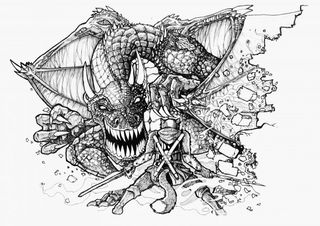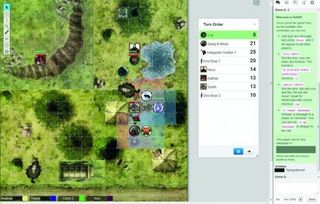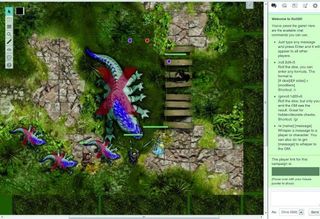How Roll 20 brings the spirit of D&D to PC

Words and illustrations by Tom Senior.
With a great iron clang, a gate opens. A dragon crashes into the room.” The group lets out a collective groan as we realise how screwed we are, but there's a hint of excitement too. We're playing Dungeons & Dragons. This is exactly what we signed up for, but it's too soon. We're only level two. Our characters have only just met. Now we're trapped in a dark basement with a famished lizard, and it's all my fault. If only I hadn't pulled that lever.
Pen and paper RPG battles traditionally unfold to the clatter of 20-sided dice and the leathery shuffle of worn character sheets. Here there is only our excited chatter and the clicking of computer mice. We're sitting at our PCs hundreds of miles apart, eyes fixed on a shared online game board built with a free program called Roll20 . Our characters are represented by small icons on an area map built and controlled by the DM. Dice rolls are resolved in a chat column to the right of the screen. That's where we learn how much trouble we're in.
We're attempting to infiltrate a nobleman's mansion by way of his basement. He has a penchant for rare, exotic creatures, which he holds captive near the entrance to his treasure vault. When the dungeon master running the session mentioned a nearby switch, I ran straight for it hoping to gain swift access to the gold. We gained access to an angry carnivore instead.

Dungeons & Dragons is one of the most admired and influential game systems of modern times, and has proved inspirational to many game designers. It's essentially a collaborative adventure simulator. A group of players choose their heroes and undertake challenges at the behest of a chief referee and campaign designer – the Dungeon Master. They lay out the scene, describes events and take charge of non-player characters to create an adaptive world for the party to explore in search of fame and fortune.
I'm new to all this – if you couldn't tell – and I'm struggling. I'm still playing as though I'm in a videogame. Why would someone put the unlock switch to their vault right next to their vault, in plain view? Before even thinking I'd blurted out the command. It was a knee jerk reaction. I'm Pavlov's action hero, trained through habit to push every button I see. In Dragon Age those habits helped me save Ferelden. In this world they make me a brazen idiot.
“Roll for initiative.” It's the phrase we've all come to fear. It's a pre-combat speed check that decides who hits who first. There's a moment of quiet as we look over our abilities and decide how the opening moments of our attack will unfold. In D&D, heroes have access to powerful strikes that can be used once a day. They're best saved for a special occasion. An unexpected dragon attack definitely counts, but the beast has the drop on us. It scans the group, takes a deep breath and then barfs everywhere.
The biggest gaming news, reviews and hardware deals
Keep up to date with the most important stories and the best deals, as picked by the PC Gamer team.

“The dragon's icy breath spews forth with the strength of a blizzard, armour creaks and flagstones crack under its freezing touch.”
The breath attack hits half of the group, deals massive damage and instantly takes most of us down to half health. We can't die down here, I tell myself, we've only just begun. I feel terrible. As adventuring faux pas go, getting your entire party eaten at level two isn't a good way to get invited back for another session. Our band of weirdos need to hit back hard.
I joined the party with many preconceptions about Dungeons & Dragons. I expected a jaunt through another grimy fantastical medieval setting. I expected to meet elves and dwarves, peasants and annoying knee-high kobolds. I expected the same world I've absorbed over and over again in Baldur's Gate, Icewind Dale and Neverwinter Nights. I was wrong.
Four editions and a wealth of official magazines and add-ons have generated a mega-trove of D&D lore. The staid, Tokien-esque lands of the Forgotten Realms are one facet of a connected universe that borrows just as much from Jules Verne and HP Lovecraft. It took three cups of tea to come up with my Hengeyokai ranger character – a shapeshifting fox spirit that can wield two blades to devastating effect.

My friends created equally strange personas, each with their own approach to dragonslaying. Chris is a Warforged warrior called Rune – a sentient metal golem from the steampunk universe of Eberron. As an opening gambit, he tries to kick the dragon back into its cell. This fails. Our gnomic bard Miles studies the creature and digs into his repertoire of songs and stories to learn more of its weaknesses. He rolls terribly. “Guys, I think it's a frost dragon!” he deduces.
Matthew steps up. He plays a humanoid from The Elemental Plane of Earth with glowing magical tattoos and fists of rock. He's a Warlord, which means he can assess a battle situation and direct allies to strategically advantageous spots, moving us around and giving us extra attacks. He points at the frost dragon and shouts “Hit that frost dragon!” and then throws in some inspiring words from a little self-help book on his belt. “True success can only come from within, or something!” That does the trick.
My ill-advised dash for the lever has separated me from the group, which means I dodged the icy breath attack. Boosted by Matthew's direction, my fox warrior deploys his powerful daily power, Jaws of the Wolf, which involves running and stabbing in a slightly more frenzied manner than usual. A series of fortunate rolls dish out plenty of pain. Perhaps I can make this brazen idiot approach work after all.
Part of the UK team, Tom was with PC Gamer at the very beginning of the website's launch—first as a news writer, and then as online editor until his departure in 2020. His specialties are strategy games, action RPGs, hack ‘n slash games, digital card games… basically anything that he can fit on a hard drive. His final boss form is Deckard Cain.
Most Popular


